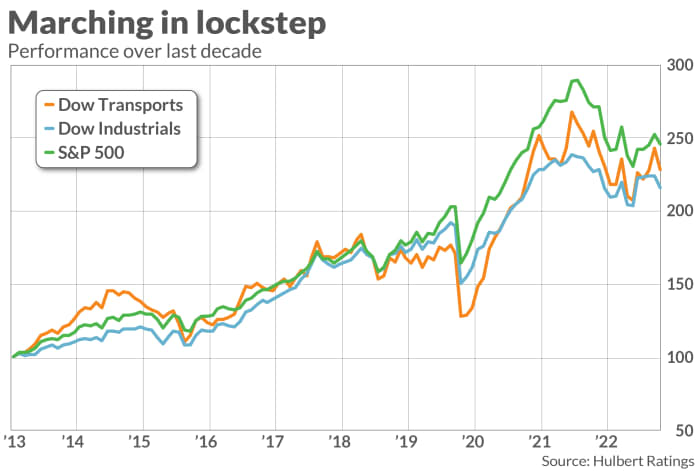
Many market experts believe that divergences between different sectors reveal a lot about the underlying health of the market. But not everyone agrees on what those separations mean.
Take the current divergence between the Dow Jones Industrial Average
DJIA,
Some advisers say this is bearish. Their rationale is that the transportation sector is a good leading indicator of the stock market. And this rationale does seem plausible, since transportation stocks, especially those of freight transportation companies, should be among the first to weaken when the economy begins to lose steam — earlier even than industrial stocks.
To test this rationale, I focused on the stock market’s performance over the past century. I used the S&P 500
SPX,
I found that neither Dow average was a consistently good leading indicator. A big culprit is the lack of any consistency. In some decades, one or other of the Dow averages was positively correlated with the S&P 500’s subsequent return, and in other decades one or both were inversely correlated. The net result was that no correlation over the entire period met traditional standards of statistical significance.
The accompanying chart illustrates this market history. As you can see, both Dow averages tend to rise and fall in fairly close lockstep with the S&P 500. They are good coincident indicators, in other words.

One reason that neither Dow average is a good leading indicator of the overall market is that their economic significance has evolved. In the early 20th century, for example, railroads played a far more crucial economic role. All but two of the stocks in the original Dow Transports were railroads; at the time it was called the Dow Jones Railroad Average. Only one of the original stocks currently remains: Union Pacific
UNP,
None of this means there is no significance to the current divergence between the Dow transports and the Dow industrials. The correct conclusion is that neither Dow average, by itself, is a good leading indicator of the overall market.
Might the existence of a divergence between the two Dow averages itself have significance? Once again, I couldn’t find evidence of it. Larger positive or negative divergences between the two indexes were not correlated with bigger or smaller subsequent gains or losses in the overall U.S. market.
Dow timing
Some elaborate market timing systems key off divergences between these two averages. Perhaps the most prominent is the Dow Theory. Though the specific rules of how to apply the Dow Theory are beyond the scope of this column, I note that Dow theorists interpret the rules differently.
Consider two Dow Theory newsletters with solid long-term records. (Neither of these two newsletters currently is among those that pay a flat fee to have their performances audited by my firm.)
One is TheDowTheory.com, edited by Manual Blay. He currently grades the Dow Theory as bullish, though in a recent email he added that he would feel more comfortable if the stock market were stronger than it has been lately.
Another Dow Theory newsletter is Dow Theory Forecasts. Richard Moroney, editor and director of research, argues that the Dow Theory is currently bearish. In an email, he explained that his newsletter won’t return to the bullish camp until the Dow industrials close above 34,589.77 and the Dow transports close above 15,640.70 — which would require gains of 5% and 15%, respectively, from recent levels.
Mark Hulbert is a regular contributor to MarketWatch. His Hulbert Ratings tracks investment newsletters that pay a flat fee to be audited. He can be reached at mark@hulbertratings.com
Plus: A stock-market milestone: Apple is now worth more than the entire Russell 2000














